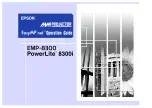
3
About blood pressure
During each heart beat the arterial blood
pressure varies between two utmost values:
the systolic and the diastolic pressure. The
peak pressure in the arteries is the systolic
pressure and the lowest pressure is the
diastolic pressure. In between these is the
Mean Arterial Pressure (MAP) which is used
to describe the average blood pressure.
Oscillometric Method
The blood pressure sensor can be used to determine blood pressure via the so-called
oscillometric method. With this method, which is non-invasive, a cuff is placed around the
arm and inflated by means of a pump, after which the cuff deflates via an automatic valve.
The sensor measures the cuff pressure. This pressure varies because of the blood flow in
the brachial artery.
With inflation of the cuff, the external pressure on the artery rises, and hence the artery is
increasingly compressed. At pressures exceeding the systolic blood pressure, the artery
will be occluded. There are weak pressure pulses against the cuff in the rhythm of the heart
beat which shows as small peaks in the graph.
When the cuff is slowly deflated, the cuff pressure, and hence the external pressure on the
artery will be lowered to that of the systolic blood pressure. Now, the artery is no longer
continuously occluded. At systolic blood pressure, small amounts of blood pass through
the compressed artery segment and cause changes in the artery volume, conducted to the
cuff. This leads to pressure oscillations in the cuff. These oscillations increase with lower
cuff pressure values, as more blood passes through the compressed artery. The maximum
oscillation amplitude is reached around the mean arterial blood pressure. Then, as the
pressure decreases until the cuff becomes fully deflated, the blood flow returns to normal
and the oscillation amplitude decreases in the cuff decreases and small pulses remain at a
low level below diastolic pressure.
The point at which the largest oscillations are occurring corresponds to the mean arterial
pressure (MAP). The point above the mean pressure at which the pressure difference grows
rapidly correlates to the systolic pressure. The point below the mean pressure where the
differences start to get small corresponds to the diastolic pressure.
A similar method is used during the regular blood pressure measurement, a clinician, using
the stethoscope, listens at the brachial artery for characteristics sounds of the pressure
pulses (so-called Korotkoff sounds).
Measurements with the Blood Pressure sensor
When performing blood pressure measurements, it is best to work with a partner.
1.
Connect the Blood Pressure sensor to your interface. Attach the rubber hose from the
cuff to the connector on the sensor.
2.
Wrap the cuff firmly around your partner’s arm, approximately 2 cm above the elbow.
The two rubber hoses from the cuff should be positioned over the bicep muscle
(brachial artery) and not under the arm.
Important:
The person having his or her blood pressure measured must remain still
during data collection—no movement of the arm or hand during measurements.
3.
Start your measurement in the Coach program.
Figure 2.
Pressure course of the heart beat in
the brachial artery.


























